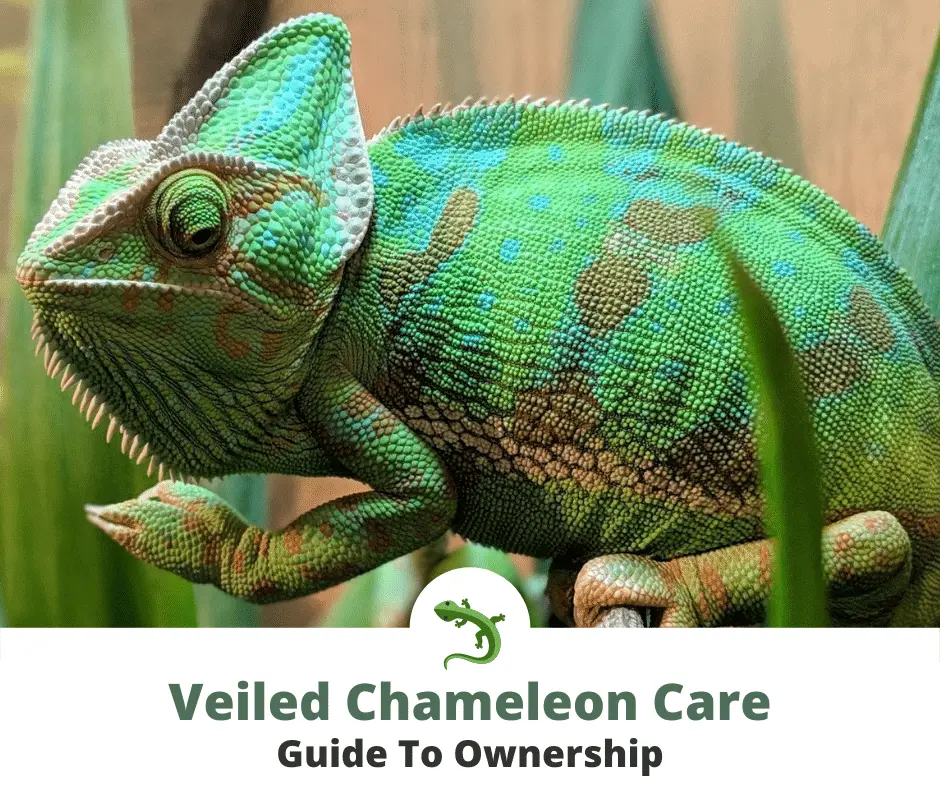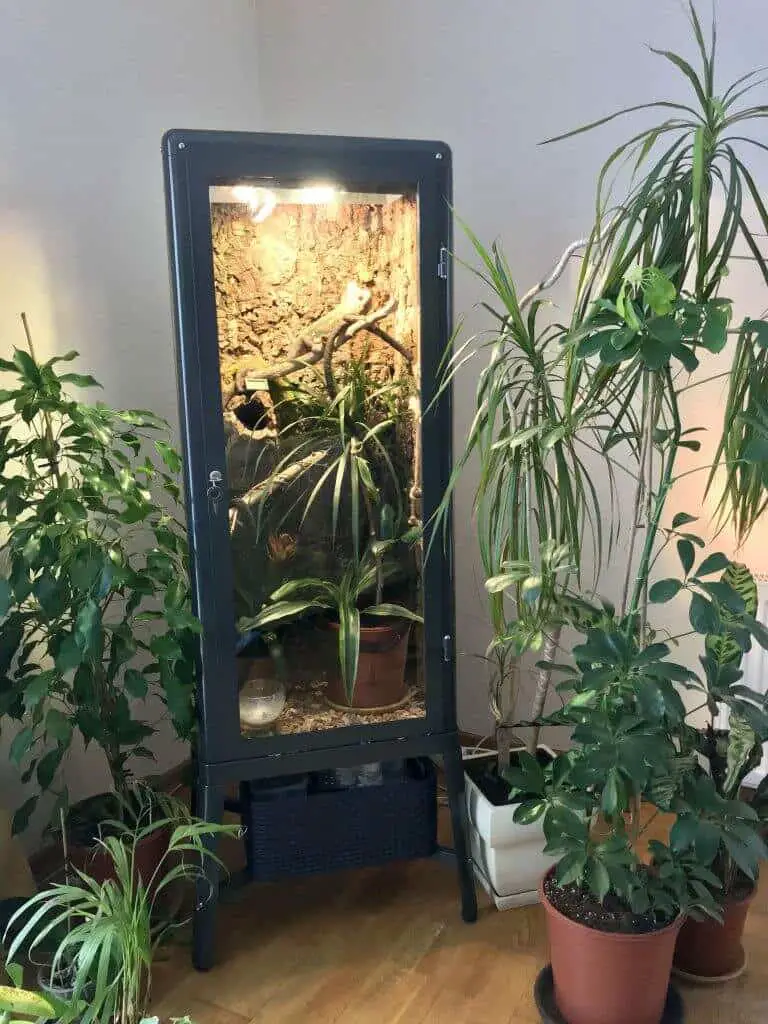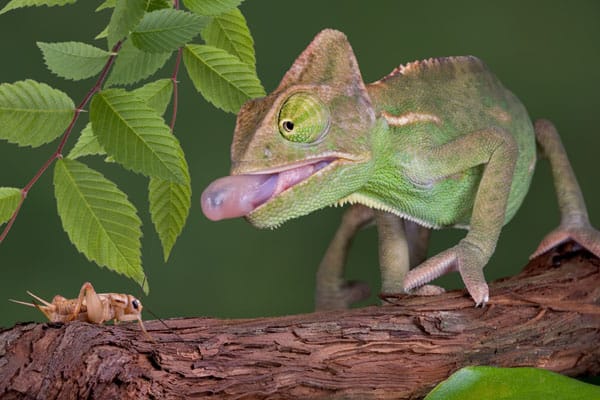Want to learn how to care for a Veiled Chameleon?
In this guide, you’ll learn:
- Do they make good pets?
- Are they hard to care for?
- What type of care do they require?
- Where can I buy one?

Veiled Chameleon Species Overview
The veiled chameleon, or Chamaeleo calyptratus, is known for their kaleidoscopic hues and patterns, uncanny ability to change skin color, swiveling eyes, and their casque (or helmet like crown) on top of their head. They are sometimes called cone-head chameleons or Yemen chameleons. They originate from the plateaus, forests, and valleys of the border between Saudi Arabia and Yemen in the Arabian Peninsula, usually living up in trees or near the ground.
They have bright bold bands on their body in yellow, blue, orange, black, or green that adjust hues based on their temperature, mood, reproduction cycle, and as a means of communication. Male veiled chameleons grow from 18-24 inches long while females are about 10-14 inches long. Veiled chameleons are omnivores and live between 5-8 years as pets.
Summary of Care
- They are docile but do not take to handling too well.
- They need taller, screened, well aerated tanks, with lots of foliage.
- They tolerate a wide range of temperature and will need UVB light.
- They need 50% humidity in their enclosures with a drip system so the water can trickle off the leaves for them to drink.
- They eat mostly insects but will take greens as well.
Behavior and Temperament
Veiled chameleons are generally docile towards humans but do not tolerate handling very well. They are usually better suited to being watched than handled. They are often recommended for more advanced reptile owners and are not suited for small children. They will get territorial and aggressive towards other chameleons so they should always be housed separately.
Housing Requirements
These lizards will need adequate ventilation so they should be placed in screened enclosures; aquariums and glass tanks are not recommended. Stagnant air will lead to upper-respiratory infections. Ideally, habitats made from mesh or screens are better, so even the sides of the enclosure are screened for proper ventilation. Their habitat can be set up outside provided that the weather is warm enough and there are safeguards against overheating.
Veiled chameleons are climbers since they live in trees in their natural habitat so taller enclosures are preferred. The recommended size is 36 x 24 x 36 inches but a height of 48 inches is even better.
Fill their cage with sturdy branches and non-toxic plants. Branches at different levels under the basking lamp will ensure a good temperature gradient. Plants such as pothos, hibiscus, and dracaena can be used as well as artificial plants and vines. Trees from the ficus family can also be used, just beware of their sap which can be irritating.

For substrate, newspaper and towels can be used as lining then covered with reptile dirt to make clean up easier. Wood chips and other small sized substrates should be avoided as these can accidentally be ingested and cause digestion issues.
As always, cleanliness of your lizard’s habitat is essential for its health so make sure their enclosure is given a good thorough cleaning at least once a month.
Heating and Lighting
Veiled chameleons tolerate a wide range of temperatures but be sure to keep it between 70-80°F during the day with a basking spot at 85-95°F. At night, the temperature should be within 65-70°F. Use a good basking lamp, an incandescent light with a reflector, or a ceramic heating element (CHE) for the warm spot in your enclosure. The CHE should be placed outside the cage to prevent burns.
Veiled chameleons, like all lizards, will need full spectrum ultraviolet light for 10-12 hours a day for their UVA/UVB light source. These bulbs should be replaced every 6 months to make sure your veil is getting enough UV light. If you want to place the enclosure in an area that gets natural sunlight (or outdoors) just be careful of overheating.
Humidity and Hydration
Veiled chameleons require moderate humidity at 50%. Daily misting of plants is recommended because they prefer to drink the water off leaves as they would in the wild. A drip or misting system works well so there’s water the trickles down the plants in the enclosure. Veiled chameleons rarely drink from bowls so it’s good to have this set up. Get a good hygrometer to make sure you are getting accurate readings since too much humidity can cause respiratory infections.
Fun Fact
A veiled chameleon’s casque or cone-shaped helmet-like thing on its head evolved to channel condensation from leaves and the air into its mouth to help it with hydration.
Food and Water
Veiled chameleons are mostly insectivores and should be fed a variety of insects every other day. They can eat crickets, locusts, roaches, butterworms (which are good for calcium), silkworms, flies, grasshoppers, mealworms, superworms, and waxworms (in limited quantities as these are high in fat). As always, wild-caught insects should not be fed to your pets since they can carry parasites and toxins. Insects should be gut-loaded or dusted with calcium supplements and other multivitamins such as vitamin D3 before feeding, at least every other day.
Baby veiled chameleons should be fed 1-2x a day while adult veiled chameleons can eat every other day. Your veiled chameleon will enjoy it if you put live insects in the foliage of their enclosure for them to hunt.

Veils will also eat plant matter so make sure the plants in the enclosure are not toxic. Vegetables and fruits can be fed to them in small amounts (collard greens, kale, squash).
Feeding should be monitored to avoid obesity and uneaten insects should be taken out of the cage after feeding. Crickets tend to attack lizards and cause wounds that can become infected.
How To Choose Your Veiled Chameleon
You should get your veiled chameleon from a reputable and responsible breeder to ensure that it is free from parasites and other infections. Watch out for cloudy eyes or any discharges from the nose or eyes that could indicate a sickness. Dry patches on the skin could also indicate a shedding problem. Once you get your Veil, you should bring it to the vet ASAP to check for parasites and other illnesses.
Veiled Chameleon Availability & Cost
Veiled chameleons typically go for as low at $50 or as much as $500 with most averaging at about $80-100. They are readily available since they have been bred in captivity with success.
Veiled Chameleon Lifespan
Veils usually live for about 6-8 years as pets when properly cared for.
Common Health Problems
Respiratory infections are a common health problem of veiled chameleons so make sure that their enclosure is well ventilated with the correct humidity levels. Mouth rot is also common and can show as redness, excess saliva, or pus around the mouth. Calcium and vitamin deficiencies from a poor diet and lack of UVB light will lead to metabolic bone disease and manifest as wobbly legs, deformation, and lethargy. A poor appetite can also be an effect of poor lighting or caused by a parasite. Stress from being handled too much can also make your veiled chameleon prone to illness.
FAQs
Do veiled chameleons make good pets?
Yes, veiled chameleons make good “display” pets as they do not take to handling very well. They can get used to it if you tame them early on but in general, they prefer not to be handled. They also require specific habitat conditions such as a taller enclosure so make sure to research about their care thoroughly before getting one.
How long do chameleons live?
Veiled chameleons can live up to seven years but typically average at 6-8. Panther chameleons live up to 3 years while Jackson’s chameleon can live between 5-10 years. Lifespan of chameleons as pets will always depend on good health brought about by proper care.
Do chameleons bite humans?
Yes, chameleons can bite humans especially during forced or excessive handling or when feeling threatened or territorial. Watch out for hissing as this usually precludes biting. Veiled chameleons are solitary and really do not like being handled too much so it may not make a good pet for children and novice reptile owners. Though they can get used to some handling when tamed early on. Their bite can be painful but it is not toxic or too harmful to humans.
How much do veiled chameleons cost?
Veiled chameleons can cost up to $500 depending on where you purchase.
What do veiled chameleons eat?
Veiled chameleons are insectivores and can consume crickets, locusts, roaches, butterworms (which are good for calcium), silkworms, flies, grasshoppers, mealworms, superworms, and waxworms.
Conclusion
Veiled chameleons are colorful and beautiful creatures that are docile towards humans but do not tolerate handling too well. Because of this, they are usually reserved for more advanced reptile owners and are often better off as “display” pets. They need a few specialized requirements for their enclosures such as a taller cage for climbing and a mesh cage (instead of a glass aquarium) for better aeration. Other than that, the usual basic reptile care applies to veiled chameleons – proper heating and lighting, humidity, quality diet, and well kept enclosures.
Further Reading
Quick facts:
Veiled chameleon
Great article with good visuals that explain how chameleons change their skin color:
Chameleon Colors Reflect Their Emotions


